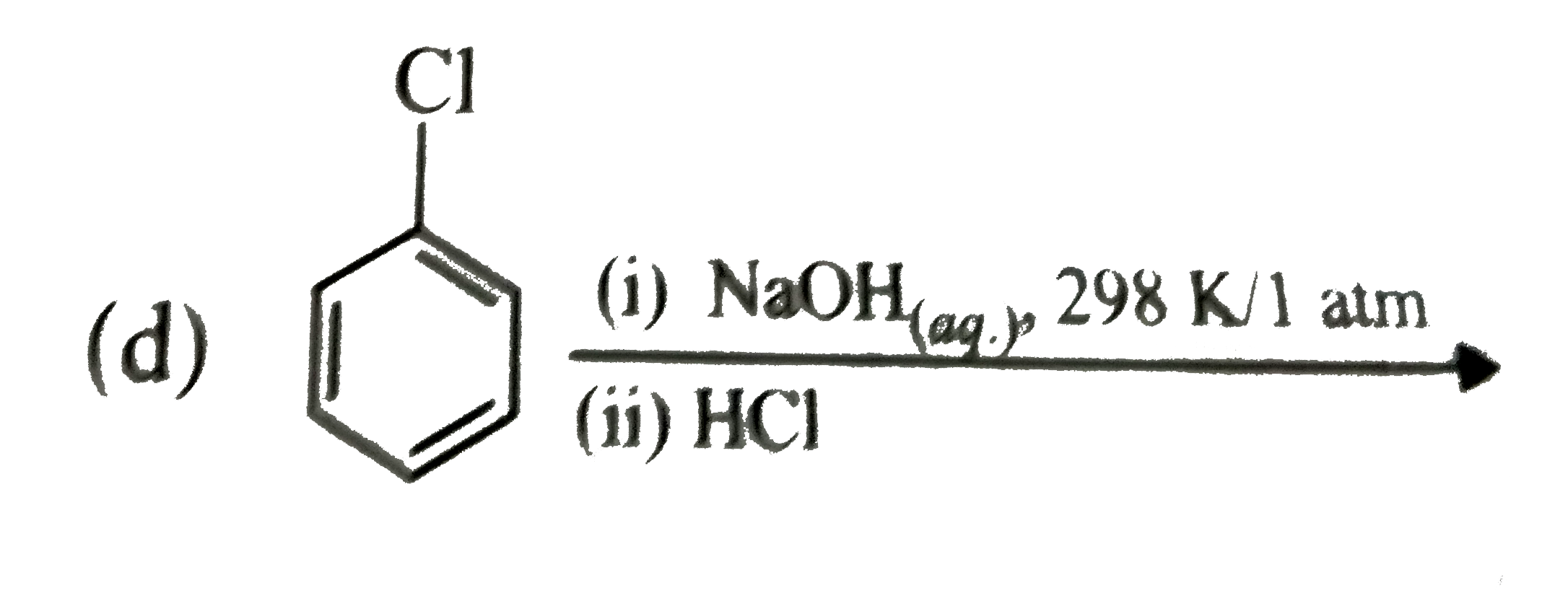Which of the reagents on reaction with cyclohexanol gives best yield of cyclohexene?
conc. HCl
conc. HBr
conc.
The correct Answer is:C
To determine which reagent gives the best yield of cyclohexene when reacting with cyclohexanol, we can analyze the options provided step by step.
1. Identify the Reagents: The question provides four reagents. We will analyze each one to see if it can convert cyclohexanol to cyclohexene.
2. Option 1: Concentrated HCl:
- Cyclohexanol reacts with concentrated HCl.
- The concentrated acid donates H⁺ to the hydroxyl group (-OH) of cyclohexanol, converting it into a better leaving group (water).
- A carbocation is formed.
- Chloride ion (Cl⁻) from HCl attacks the carbocation, resulting in the formation of chlorocyclohexane.
- Conclusion: This does not yield cyclohexene.
3. Option 2: Concentrated HBr:
- Cyclohexanol reacts with concentrated HBr.
- Similar to HCl, HBr donates H⁺ to the -OH group, forming a good leaving group.
- A carbocation is formed.
- Bromide ion (Br⁻) attacks the carbocation, leading to the formation of bromocyclohexane.
- Conclusion: This does not yield cyclohexene.
4. Option 3: Concentrated Phosphoric Acid (H₃PO₄):
- Cyclohexanol reacts with concentrated phosphoric acid.
- H₃PO₄ dissociates to provide H⁺, which protonates the -OH group, forming a good leaving group.
- A carbocation is formed.
- Instead of a nucleophile attacking the carbocation, dehydration occurs, where water leaves, resulting in the formation of cyclohexene.
- Conclusion: This yields cyclohexene.
5. Option 4: Lucas Reagent:
- Lucas reagent is used to differentiate between alcohols based on their degree (1°, 2°, 3°).
- It does not promote dehydration to form alkenes.
- Conclusion: This is not the correct option for forming cyclohexene.
Final Conclusion:
The best yield of cyclohexene is obtained when cyclohexanol reacts with concentrated phosphoric acid (H₃PO₄).
- Cyclohexanol reacts with concentrated HCl.
- The concentrated acid donates H⁺ to the hydroxyl group (-OH) of cyclohexanol, converting it into a better leaving group (water).
- A carbocation is formed.
- Chloride ion (Cl⁻) from HCl attacks the carbocation, resulting in the formation of chlorocyclohexane.
- Conclusion: This does not yield cyclohexene.
- Cyclohexanol reacts with concentrated HBr.
- Similar to HCl, HBr donates H⁺ to the -OH group, forming a good leaving group.
- A carbocation is formed.
- Bromide ion (Br⁻) attacks the carbocation, leading to the formation of bromocyclohexane.
- Conclusion: This does not yield cyclohexene.
- Cyclohexanol reacts with concentrated phosphoric acid.
- H₃PO₄ dissociates to provide H⁺, which protonates the -OH group, forming a good leaving group.
- A carbocation is formed.
- Instead of a nucleophile attacking the carbocation, dehydration occurs, where water leaves, resulting in the formation of cyclohexene.
- Conclusion: This yields cyclohexene.
- Lucas reagent is used to differentiate between alcohols based on their degree (1°, 2°, 3°).
- It does not promote dehydration to form alkenes.
- Conclusion: This is not the correct option for forming cyclohexene.
The best yield of cyclohexene is obtained when cyclohexanol reacts with concentrated phosphoric acid (H₃PO₄).
Topper's Solved these Questions
- ORGANIC REACTION MECHANISMS-IVBOOK - RESONANCE ENGLISHCHAPTER - ORGANIC REACTION MECHANISMS-IVEXERCISE - Exercise-3 Part-2 JEE (MAIN ) OFFLINE PROBLEMS
10 Videos
- ORGANIC REACTION MECHANISMS-IVBOOK - RESONANCE ENGLISHCHAPTER - ORGANIC REACTION MECHANISMS-IVEXERCISE - Exercise-3 Part-2 JEE (MAIN ) ONLINE PROBLEMS
10 Videos
- ORGANIC REACTION MECHANISMS-IVBOOK - RESONANCE ENGLISHCHAPTER - ORGANIC REACTION MECHANISMS-IVEXERCISE - Exercise-2 Part-4
8 Videos
- ORGANIC REACTION MECHANISMS - IIBOOK - RESONANCE ENGLISHCHAPTER - ORGANIC REACTION MECHANISMS - IIEXERCISE - APSP Part - 3
22 Videos
- PERIODIC TABLE & PERIODICITYBOOK - RESONANCE ENGLISHCHAPTER - PERIODIC TABLE & PERIODICITYEXERCISE - ORGANIC CHEMISTRY(BASIC CONCEPTS)
27 Videos
Similar Questions
Knowledge Check
Which of the following reactions will not yield phenol ?
A B
B C
C D
D
Which of the following reactions would give the best yield of t-butyl methyl ether?
A(CH3)3C−OHH2SO4−−−→140∘CB(CH3)3C−Br+CH3OH→C(CH3)3C−Br+CH3өONa⊕→D(CH3)3C−өO⊕K+CH3Br→Cyclohexanol can be converted into cyclohexylamine by following two routes. Which of the following methods is expected to give good yield of cyclohexylamine ?
A B
B Cboth are equally suitableDneither of the two
Cboth are equally suitableDneither of the two
Give a chemical test and the reagents used to distinguish between cyclohexane and cyclohexene.
View SolutionWhich of the following reactions does not yield an amine?
View SolutionWhich reagent gives pink colour with aldehyde ?
View SolutionWhich of the following is the best reagent to convert 1-Methylcyclohexene into 2-methylcyclohexanol ?
View SolutionWhich of the following alcohols gives the best yield of dialkyl ether on being heated with a trace of sulphuric acid ?
View Solution
